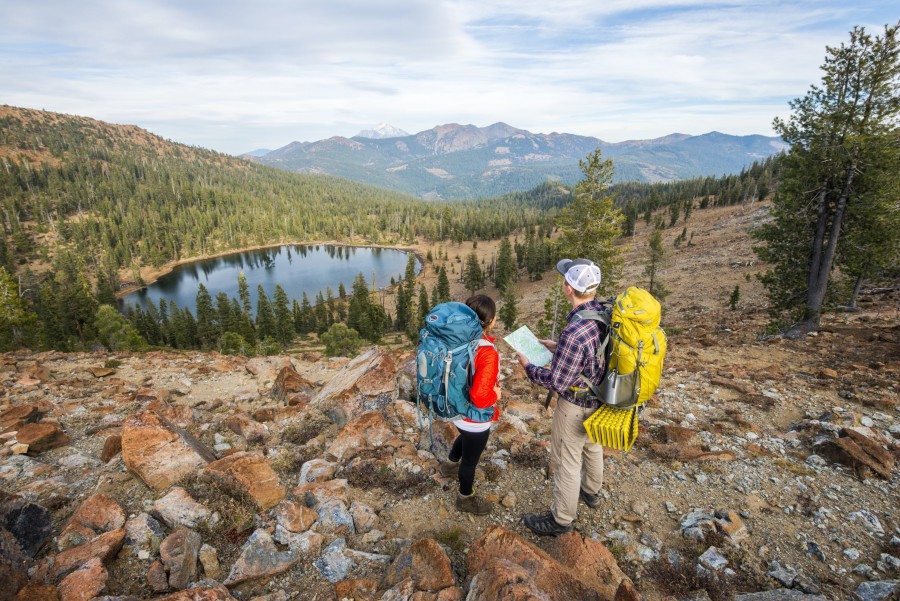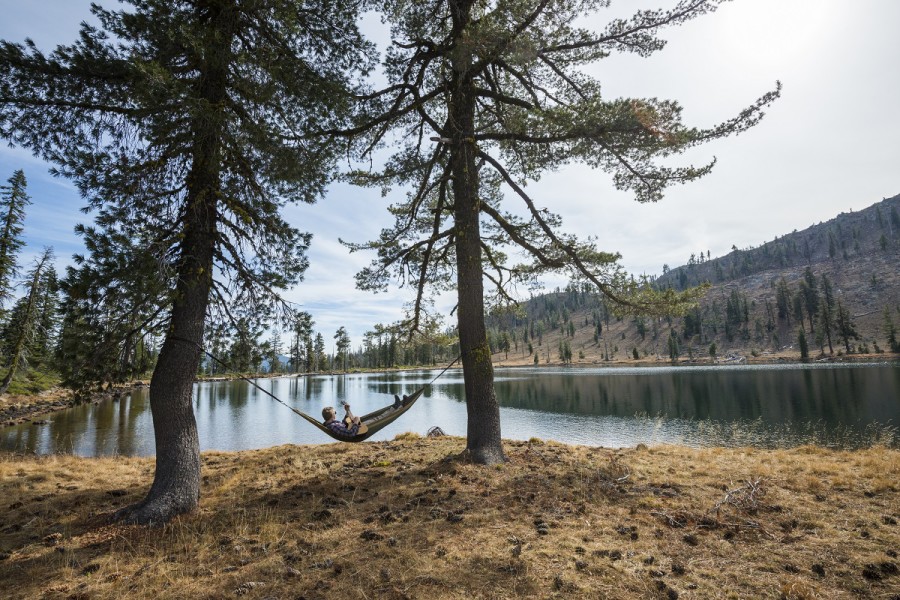The Conservation Alliance awarded the Pacific Crest Trail Association a $50,000 grant in September 2016 to support their Pacific Crest Trail-Trinity Divide land acquisition project. This purchase, in partnership with the landowner, will permanently protect 10,600 acres, the headwaters of four rivers, 17 miles of the Pacific Crest Trail (PCT), nine alpine lakes, and numerous mountain meadows and springs. Megan Wargo, the Director of Land Protection for the Pacific Crest Trail Association, explains why conservation of this area is so crucial and how you can support this effort and other public land acquisition projects funded by the Land and Water Conservation Fund (LWCF).
For most of the 2,650 miles of the PCT from Mexico to Canada, you can experience some of the most sublime outdoor scenery in the world. But in far too many spots along the way, this experience is being threatened by development, clear cuts, inappropriate barriers and unsafe road walks. Nearly 50 years after the 1968 Congressional designation of the PCT as one of the first National Scenic Trails, it is still not completely protected. Approximately 10 percent of the trail remains on private land with little in place to help protect the trail experience for future generations.
In most cases, there are trail easements on these private parcels that grant hikers and equestrians the right to pass through. However, many of these easements are less than 30 feet wide and do not protect the larger landscapes surrounding the trail. New construction and development could happen at any time on private property along the PCT. If it does, it could forever alter the trail experience.
Trinity Divide—Many Public Benefits

The Pacific Crest Trail Association (PCTA), The Trust for Public Land, the Michigan-California Timber Company and the U.S. Forest Service are spearheading the effort to protect this northern California timber property that includes 17 miles of the Pacific Crest Trail, and we’ve secured funding for the first of three phases for this important project.
The Michigan-California Timber Company (MCTC) is seeking to sell and protect its Trinity Divide property just west of Mount Shasta, where today, the PCT threads a narrow 10-foot-wide private easement along a scenic ridge with expansive views of mountains, lakes and forests.
You might not know it if you were out there, but starting just north of the Gumboot trailhead and continuing for nearly 30 miles to the Scott Mountain trailhead, PCT users pass through a checkerboard of public and private land.
The checkerboard ownership pattern is the legacy of the 1862 railroad land grants, which gave every other section of federal land along a proposed rail corridor to the railroad companies. It was a way of opening the West to settlement and development as well as increasing the value of the remaining public land in a bygone era. In more modern times, this public-private land pattern has created problems for public access and ecological management across the western United States, and is the leading cause for private inholdings within national forest boundaries.
The Trinity Divide is a key property for the protection of the PCT that includes many public benefits:
- Acquire 10,600 acres—more than 16 square miles—for hiking, fishing, horseback riding, hunting, camping and exploration. The land would be added to the Klamath and Shasta-Trinity national forests.
- Secure a protected corridor for the PCT along 30 miles of the trail, 17 of which cross private property on a narrow right-of-way easement.
- Conserve wildlife habitat of renowned biological diversity, including: meadows, lush valleys, low marshes and cold water springs.
- Protect waters for four river systems, including salmon and steelhead habitats in the Trinity and Klamath river basins.
- Open new public access to 10 alpine lakes that are on private property.
- Enhance access to existing public lands through the potential to develop new loop hikes using the Sisson-Callahan Trail, which crosses these private lands.
Land and Water Conservation Fund – First Phase Secured

An acquisition project of this size is generally accomplished over many years and purchased in phases. We are excited to tell you that we’ve secured $4.5 million in federal funding for the first phase of the project through the Land and Water Conservation Fund. The PCTA, The Trust for Public Land and MCTC worked with the Forest Service to submit a request for LWCF dollars for the 2017 federal Fiscal Year. It’s the largest appropriation the PCT has ever received in a single year and the largest appropriation for a Forest Service project this year.
The LWCF sets aside a small percentage of the royalties from offshore energy production for state and federal conservation programs. Think of it as a mitigation program. Oil and gas explorers pay the American people for the rights to extract energy with the realistic expectation of environmental impacts, and then a small portion of what they pay is set aside to preserve land elsewhere that might otherwise be developed or exploited. For more than 50 years, the LWCF has protected parks, forests, wildlife refuges, public lands and other community spaces through locally driven conservation efforts. Without spending any tax dollars, this program supports water quality enhancement, protection of fish and wildlife habitat, agriculture and forestry on private lands and access to public land for recreation.
The LWCF is an overwhelmingly popular program with the American people and has maintained bipartisan support in Congress. The omnibus appropriations bill for Fiscal Year 2017, which Congress passed in April, included $400 million for LWCF.
Fiscal Year 2018 Land and Water Conservation Fund—What Can You Do to Help?
The LWCF will be a crucial part of the funding needed to complete the Trinity Divide protection project. While we continue to move forward on the first phase of the acquisition, efforts are already underway to try and secure LWCF funding for our second phase of the project. This acquisition remains a high priority nationally for the U.S. Forest Service, however, federal land acquisition is not a priority for the current administration.
The president’s Fiscal Year 2018 budget proposal calls for drastic cuts for federal land acquisition programs. The president’s budget would gut the LWCF by 84 percent. This funding level would cover administrative costs only, no new land acquisitions. Failure to fund the LWCF in Fiscal Year 2018 and provide continued funding to the Trinity Divide project, could mean a lost opportunity to acquire and protect this property forever.
The House has approved a FY2018 Interior Appropriations bill that would fund LWCF at $275 million, far below the $900 million allowed under the program. While the House vote is a welcome rejection of the administration’s proposal, it would still cut LWCF by 32% over FY2017 levels. The Senate Appropriations process is still underway. Senate Interior Appropriations Committees are working with agency leaders now to prepare the FY2018 Interior Appropriations Bill, which includes the LWCF. Your congressional representatives need to hear from you. Tell them that the LWCF and the legacy of the Pacific Crest Trail and our public lands are important to you. Here’s a searchable website that will help you find contact information for your senators and Congress members.
Please contact your representatives in the House and the Senate to insist on:
—At least $400 million in overall funding for LWCF consistent with Fiscal Year 2017 funding levels.
—$54.8 million allocated for 72 projects along national scenic and historic trails, including the Pacific Crest Trail Trinity Divide Project in Siskiyou and Trinity counties in California.
—Permanent reauthorization of the Land and Water Conservation Fund: H.R. 502 and S. 569 amend the Land and Water Conservation Fund Act of 1965 to permanently reauthorize the LWCF.


